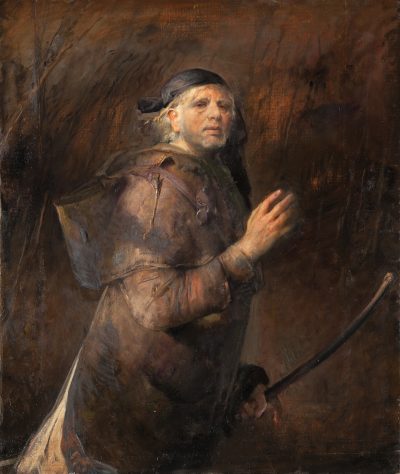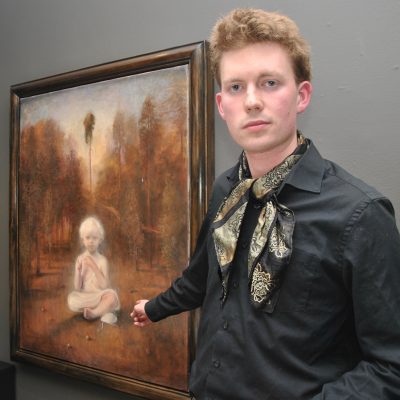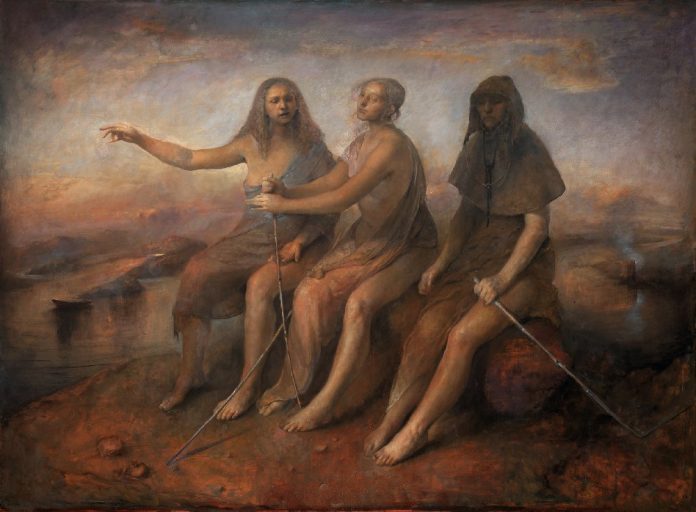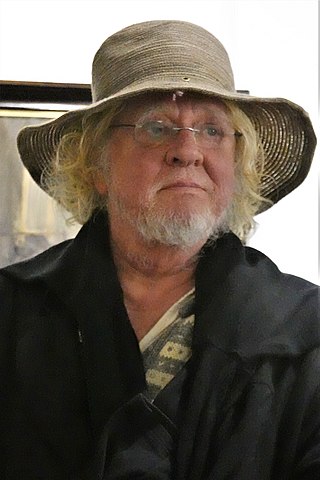Norwegian artist Odd Nerdrum has mounted an attention-grabbing comeback, more than two decades after his last exhibition in Norway. True to form, though, and disappointing fans, he did not show up when the largest display of his work to date was unveiled in Oslo.

The exhibition at the gallery Fineart Oslo, ambiguously titled You see we are blind, presents more than 50 previously unseen works by Nerdrum. More than 1,000 people attended the opening, many hoping in vain to get a glimpse of the much talked-about artist who rarely appears in public.
You see we are blind extends dystopian themes that Nerdrum, now age 77, has explored in recent decades: suffering and decay embodied in unglamorous naked humans, fighting for survival in gloomy, barren landscapes. Most of the exhibition is found in the dimly lit basement of the gallery, adding to the creepy ambience of twilight and apocalypse communicated by the paintings.
No price list was made available for the exhibition but Fineart manager Rolf Stavnem told NewsInEnglish.no that “we’re happy with sales this far, and have some exciting processes going.”

The pictures were created over the last 20 years, a period when Nerdrum has mostly avoided the public eye. He has not wanted to exhibit his art since a 1998 retrospective exhibit at Oslo’s Astrup Fearnley Museum that an estimated 70,000 people came to see. He prefers instead to paint and to guide students at his private art school in Norway, and cultivate an outsider’s image.
Most media coverage of Nerdrum will mention his bitterness and belief that he’s misunderstood and rejected, despite being respected as one of Norway’s greatest contemporary artists. He also earns well on his art. Nerdrum, however, spent years in court after failing to pay necessary taxes on his art sales and faced time in jail until receiving a pardon from King Harald V in 2017. He is also known to be unhappy that some of Norway’s major art institutions don’t own his works, and that those that do, don’t display them often enough.
Nerdrum declared long ago that he would never talk to Norwegian media again, although media folks would gladly talk to him. He has sometimes broken that promise, though, most recently in a 12-page cover story in D2, a high-end weekly magazine published by business newspaper Dagens Naeringsliv.
In that rare interview, Nerdrum described his goal: “To create a significant work of art that’s allowed to hang somewhere.”
Nerdrum is often represented by his youngest son Öde, age 26, who has taken on a role as a spokesperson of sorts for his father. It was Öde who spoke on behalf of his father at the exhibition opening.

“I believe Odd Nerdrum has been very nervous,” Öde Nerdrum told NewsinEnglish.no afterwards. “When it comes to attending his own vernissage and presenting his work, he is simply a bit of a wimp.”
The younger Nerdrum went on to say that “meeting other people can be a scary thing” for his father, “and even moreso when it’s about presenting his work.” Öde said his father “spends so much time on each picture to make sure it’s good enough, and attaches a lot of emotion to it. Describing his feelings using words is hard for Odd Nerdrum. He does that with his paintbrush. Having said that, I think he’s very relieved now to finally present a number of pictures.”
Öde Nerdrum admitted to being nervous himself. “When my father presents things, it’s almost like an extension of myself, so I get nervous too. But that goes away now that I’m here and get to see pictures like this shine,” he said, gesturing to a painting of a little boy called Ett og et halvt år (One and a half years).
“It’s a fantastic exhibition. And it’s equally fantastic so many people come to see works of art that have something to them,” the younger Nerdrum said, not just because people are talking about them.
The story continues below the image.

Mona Pahle Bjerke, a critic for state broadcaster NRK, reported that she found “treasures and trash” at the exhibition, however. She said You see we are blind shows how good Odd Nerdrum is at his best, but also that he allows himself to produce sloppy work. Bjerke found paintings that seemed unfinished: perfect faces and bodies left in an unexciting “brown soup.”
She did find at least one masterpiece, though: Five singing women, showing five naked women and a child lying on the ground singing, viewed from above. “Both in composition and colour-wise it’s so masterfully executed that we don’t even ask why these people are lying on the ground singing.”
She also said it’s “understandable” that Odd Nerdrum has felt overlooked by Norway’s state art institutions. “Just the fact that the National Museum has failed to secure the key works from Nerdrum’s golden era is and will remain a scandal,” Pahle Bjerke said in her review.
Art critic Lars Elton complained of “a lot of strange anatomy” and “sloppily painted details.” In Elton’s opinion, “what we see in several of Nerdum’s paintings this time is so different from ideals he used to uphold, that it’s fair to ask whether he gives a damn about his idols,” known to be Rembrandt and Caravaggio, two classic 16th century masters. Elton, writing in newspaper Dagsavisen, said the exhibition reflects hard work over a long period of time, but also noted that the time frame is 22 years. Five singing women is dated 2001. Elton reckoned Nerdum did better work with similar compositions long ago, for example Dawn (1990) which was purchased by rock star David Bowie.
The story continues below the image.

Most national newspapers appear to have ignored Nerdum’s exhibition. He did, however, find a friend in the right-wing website Document.no, whose reviewer Paul Grøtvedt hailed Nerdrum’s project as “a bright spot in artistic terms, but at the same time a pitch dark account of the spirit of our time, and its rejection of values and hatred for culture.”
The exhibition comes less than a year after another tense encounter between Nerdrum and Norway’s art establishment. In the autumn of 2021 he was rejected at Høstutstillingen, a key annual art event in Norway. The rejected piece, a large painting called Tre menn i en båt (Thee men in a boat), went on display at the Fineart gallery instead. That time, the artist himself actually showed up, explaining he had intended the painting “to pave the way a little” for gifted artists he knows of, both in Norway and abroad. He also told media, “I’m used to being rejected quite a few places, and in many (different) situations.”
Odd Nerdrum never made it easy for himself. When he joined Norway’s State Academy of Art in 1962, he wanted to paint figuratively in the classic sense, but his modernist curriculum was packed with the abstract. His teachers “couldn’t teach me anything,” he once recalled. According to an unsigned biography published by Fineart.no, Nerdrum literally saw the light during a student excursion, faced with a glowing Rembrandt in Sweden’s National Museum. His fellow students were busy studying Warhol and Picasso over at Stockholm’s Modern Museum. So he quit the academy, opting instead to educate himself by learning from artists who had been dead for centuries. In 1965 he attended Kunstakademie Düsseldorf, a classic German art school.
The story continues below the image.

Among his mentors in early life was the late Jens Bjørneboe, a controversial Norwegian author who also taught at the private Rudolf Steiner school in Oslo. Bjørneboe worried that Nerdrum’s self discipline would isolate him from fellow students. But in his final assessment, Bjørneboe wrote that “Odd is perhaps the most unusual and original student I’ve ever had. In many ways he’s a lonesome bird, but he is interested in many things and therefore connects with others easily,” wrote Bjørneboe, as quoted by D2.
Similar things were said the first time Nerdrum’s art appeared in public, at a group exhibition in Oslo in 1964. His figurative, “oldmasterly” style made him stand out from the other invited artists.
Nerdum’s first separate exhibition took place in 1967, when he was 23. “I see our present from a diagnostic point of view,” he said at the time. “I try to depict the world we are in and the one that’s coming.”
By that time, commentators called his work things like a romantic-realistic protest against modernism, and a “special Norwegian phenomenon.” One art historian, Gunnar Sørensen, reckoned that “neither Rembrandt nor Velazquez are Nerdrum’s closest kindred spirits. He rather belongs in the tradition from Tidemand, Christian Skredsvig and Christian Krohg.”
The young and largely unknown Nerdrum was noticed for a slightly different reason, too. A painting he had called Tidens skjønnhet (Beauty of the times) was used as cover art on the first double album ever released in Norway: The 1971 Friendship by Junipher Greene, an influential “progressive rock” band at the time. According to newspaper Dagbladet, Nerdrum had painted it a couple of years earlier.

“Odd had lined up several paintings that we could choose from. We paid him NOK 250 for the rights to use his painting on our album cover,” Geir Bøhren, a band member, once recalled when interviewed by newspaper Dagbladet. The amount equals around NOK 2,200 (USD 250) today.
Friendship has been rated the best Norwegian album ever, and the first edition of it is a valuable collector’s item. Preparing a re-release of the album in 2008, Bøhren asked Nerdrum where the painting could be found.
“Odd told me that he’d destroyed the picture along with more of his early works. He said they were work from his youth that he was not happy with,” Bøhren told Dagbladet.
The Dagbladet article also shed some light on the techniques used by the young Nerdrum. According to one of his fellow artists, Johan Gulbranson, the group of elegant young trendies seen in Tidens skjønnhet were not in the same room when painted. Instead they came one by one to Nerdrum’s studio behind Kunstnernes Hus (The Artists’ House) in Oslo where they were added to the picture. Some of the models were friends whom Nerdrum often painted at the time.
“He had set up a mirror at the other end of the room which he looked at when working. Thus, he painted us from our mirrored image, He never looked at us,” Gulbranson recalled.
In 1978 Nerdum unveiled Mordet på Andreas Baader (The Murder of Andreas Baader), rated as one of the most political pictures ever made by a Norwegian artist. The huge painting appears to depict a murderous terrorist as a martyr. Andreas Baader was convicted in Germany of multi-manslaughter and other serious crimes as the head of the Baader-Meinhof terrorist group, and died in his prison cell. According to an official inquiry, the death was a suicide. But a popular conspiracy theory in European left-wing circles at the time would have it that he was murdered by the authorities.
The painting stirred controversy in Norway and internationally, not least in West Germany. As model for Baader’s face, Nerdrum used Trygve Hegnar, an editor and investor.
In the 1980s, Nerdrum changed his style considerably. His colorful romantic realism was replaced by a gloomier view of the world, adding darkness, symbols and suffering humanoids in brutal landscapes, sometimes wearing helmets. Harald Flor, a Dagbladet art critic, wrote enthustiastically about “the new Nerdrum,” and found his fresh work far more original than that of previous decades. During his long absence from public life, Nerdrum has perhaps refined this theme, resulting in the mostly disturbing works now on display.
Odd Nerdrum has defined his art as “kitsch” since 1997, and describes himself as a “kitsch painter” who is part of a “kitsch movement.” Kitsch is normally used about art that’s poor, cheap or fake. It’s believed that Nerdrum chose to use the term sarcastically, as a poke at his critics.

Nerdrum has a history of reaching out to fellow artists. For decades, he cooperated with Norwegian colleagues like Karl Erik Harr, Arne Paus and Bjørn Fjell in organizing a series of art exhibitions titled “Romanticism and realism.” He likes to advise younger artists, too, making for the term “Nerdrum students.” Among them are Trine Folmoe, Sverre Koren Bjertnæs and others. A 2013 book, The Nerdrum School: The master and his students, contains works by more than 80 Nerdrum students from around the world.
His art school is based in Stavern, a small town on the shores of the Oslo fjord. Nerdrum reportedly doesn’t charge his students anything, and he doesn’t read applications to join, but he does look for talent.
“They’re here as students and assistants,” Nerdrum told D2. “I’m not a good teacher, but I can teach them quite a bit about philosophy.” He added that his students all share a disinterest in modernism: “The students aren’t properly at home in modern society. They don’t recognize it. Typical for modern people is that no one needs to go in-depth. We have robots to do that.”
newsinenglish.no/Morten Møst
• You see we are blind will run in Oslo until April 13. On April 27 part of it will reopen as You see we are blind II in Stavanger’s BGE Contemporary Art Projects with more works added.

